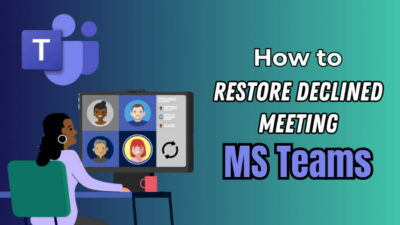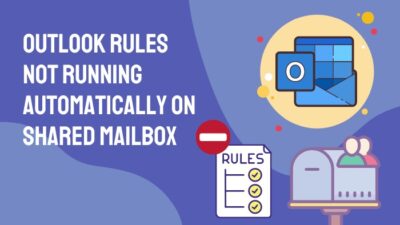Research says more than 40% of SharePoint implementation is unsuccessful due to the lack of clear understanding and proper business plan.
Microsoft SharePoint offers numerous options to businesses and organizations. But to utilize the features, you need a clear vision and resources to decorate the goals.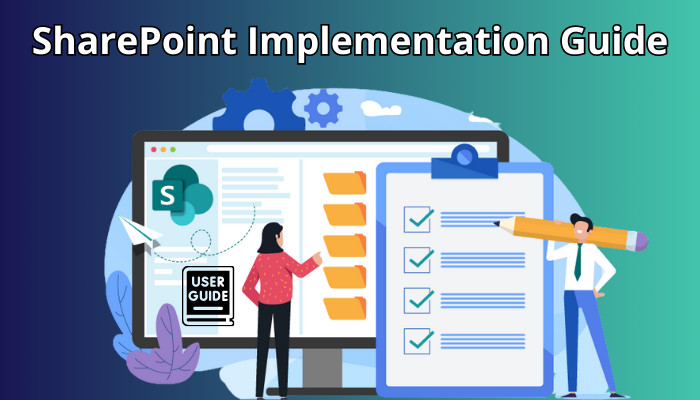
In this article, I’ll discuss the types of SharePoint implementation and provide tips for a successful SharePoint implementation to increase the business ROI.
So, let’s start.
Key Takeaways
- Definition of Microsoft SharePoint.
- Importance of SharePoint implementation.
- Types of SharePoint implementation and their description.
- Microsoft SharePoint complete implementation guide.
- Essential factors to increase the return on investment in SharePoint implementation.
- Techniques to increase user adoption.
- The estimated cost of SharePoint implementation.
SharePoint is a web-based platform for working collaboratively with group members and external teams. It’s a secure place to store, organize, share, and access information about the organization with workflows, web parts, and other security features.
Microsoft SharePoint is a great place to create an intranet site to manage your teams efficiently. Making the sites is straightforward, and anyone can do it without basic coding knowledge.
It’s vastly used by small to massive organizations, and multiple Microsoft services and countless add-ins make the system more beneficial for creating a flow of work.
SharePoint is the pillar for every Microsoft cloud storage feature from services like OneDrive and Teams.
Everything in Microsoft service is connected with SharePoint, which makes it ideal for implementing any business or organization model to this platform.
Microsoft SharePoint is packed with lots of services and add-ins. But that doesn’t mean it can be helpful for your business environment. A good and proper implementation is crucial to make all the services work and get the maximum benefit from it.
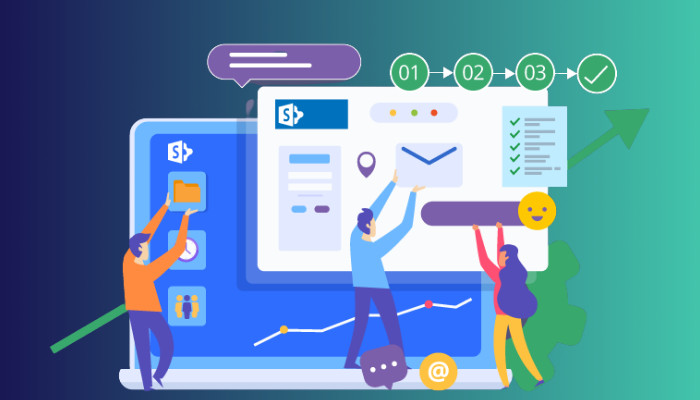
A good SharePoint implementation can offer better collaboration and communication with teams and groups. It makes teamwork more effective and efficient.
An automated workflow service can simplify tasks, create projects, organize, and ensure consistency and compliance with rules and policies. You can collect and order your essential documents and use them for your work.
Good SharePoint implementation guarantees data security and protects the document from damage or theft.
All these things are necessary for running a business fluently and require lots of planning and implementing SharePoint. Without the proper implementation, the work and communication will scatter and create a mess in the work environment.
To prevent any hindrance to your business, select your SharePoint implementation type and approach to your goal.
Microsoft SharePoint has two versions, SharePoint Online and SharePoint Server. Depending on your organization’s requirements, choosing the correct SharePoint version is crucial. It ensures the best way to structure SharePoint and increases the possibility of a successful implementation.
Both versions have similar fundamentals and functionalities. The basic features are the same in both Online and Server. The main differences lie in storage capacity, infrastructure, requirements, customization, control, and cost.
You must choose the right one and implement your platform based on your budget, capacity, and specific needs. The decision depends on some key factors, and they are:
- Who are the users
- What service does the user want
- What content are you providing
- What will be the project
By understanding the user’s needs and your capabilities, you can determine your scope and approach for it.
A glimpse of the SharePoint versions will give you ideas about picking and getting started with your business plan.
Microsoft SharePoint Online is a cloud-based service that offers Office 365 products to its users. Microsoft offers storage and server facility to accommodate your platform and documents.
All information goes to the Microsoft server over the internet and is not recommended if you have a strict data policy.
Here are the characteristics of SharePoint Online:
- Data Size: Microsoft provides 1 TB of storage to the SharePoint organization members, which can go up to 5 TB depending on plans.
- Cost: You only need to pay for the plans monthly or yearly. The minimum plan is the Microsoft 365 Business Basic, starting from $6.00 user/month.
- Infrastructure: Microsoft SharePoint Online is cloud-based, and there’s no need for hardware and server. Microsoft handles the maintenance, updates, and patches required for SharePoint.
- Control & Customization: As Microsoft hosts the server, users don’t have any control over it. You can only make customizations to the organization settings.
SharePoint Server is the on-premise service by Microsoft. With this service, you’ll pay for the license and establish the facility on your server.
All the data will be stored in your server storage, and you have complete authority over the data and protection.
Read the characteristics of SharePoint Server below:
- Data Size: The data storage option is limitless in Microsoft SharePoint Server. You install new storage and store all your data in there.
- Cost: The licensing cost in SharePoint Server is similar to Online. You must buy a Microsoft Business plan for the Server.
- Infrastructure: In SharePoint Server, you need to purchase dedicated hardware and server, such as SQL Server or Windows Server.
- Control & Customization: As you implement the service to your server, you have complete control over the SharePoint server and can customize settings by your needs.
After selecting the SharePoint type, depending on your requirement, it’s time to start the implementation process. Before starting the journey, you need to set your vision, organize a team, plan & test projects, and provide the required training and support to the members.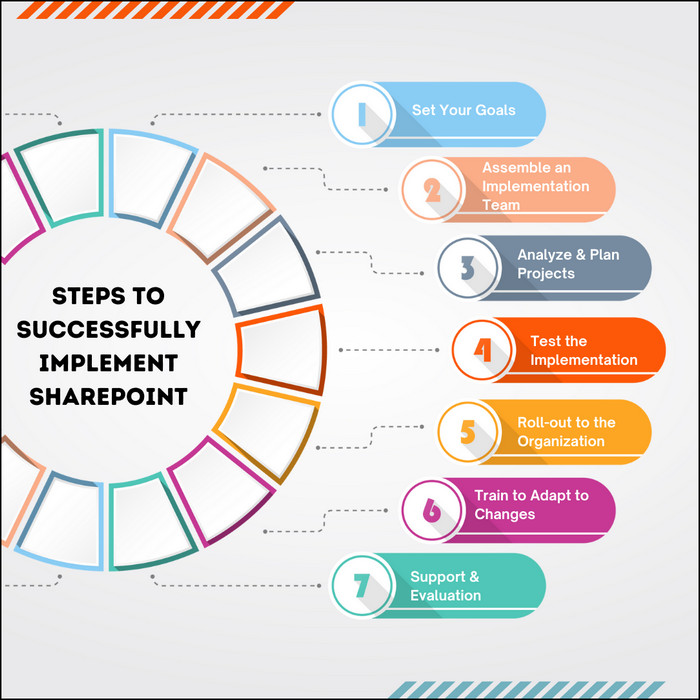
SharePoint interface may seem easy to you, and dive into it for implementation. But you shouldn’t start doing it in a hurry.
You need a well-planned outline to understand the requirements, create a good project, and drive user adaptation to increase the success rate and reduce the risk.
The following passage will describe the phases of SharePoint implementation and make your goals easier to understand and execute.
Here are the steps for successful SharePoint implementation:
1. Set Your Goals
Your first task would be to set your vision. You need to identify your business stakeholders and discuss with them about your project.
With business or organization management, you’ve to determine the service you will provide and which resources you’ll need to accomplish that. You need to set up a business map and approach them individually.
After setting the basic strategy, implement SharePoint in your organization according to the plans.
2. Assemble an Implementation Team
Before starting the SharePoint implementation process, you must gather experts and make a team. The team will contain business decision-makers, IT architects, administrators, project managers, and others.
They will play a significant role in structuring the platform. The team will integrate your content into SharePoint and create a workflow.
3. Analyze & Plan Projects
With the SharePoint team, you must analyze the project and plan how to implement the service on your site. You need to set your priorities and focus more on them.
You must gather knowledge from business models and architect your project with best practices. The implementation team will decorate the platform by your requirements and automate the necessary services.
Migration, rules creation, changing permission from Admin Center or PowerShell, user management, and other settings will be handled by the team and implemented in your environment.
4. Test the Implementation
Before rolling out the SharePoint implementation, testing the services are vital. You must check the service availability, working conditions, managing capabilities, data security, document sharing, and other necessary features.
The best technique would be to assign a single department to the test and take their feedback about the services. You need to change the settings or features to make it more smooth.
Gradually test the implementation in every department and do a final testing with all departments before the rollout.
5. Roll-out to the Organization
The roll-out version will include all the changes made during the pilot test period. It’s the final edition of SharePoint implementation, and every member of your business and organization will be able to access them.
You must assign members to their dedicated group, department, and IT admins to manage SharePoint implementation.
Even after rolling out SharePoint in the organization, there will still be room for improvement. You must gather feedback, continuously test, and publish new versions.
6. Train to Adapt to Changes
Your organization needs continuous SharePoint implementation to catch up with new services. It requires knowledge about the changes to adapt to the upcoming modifications.
Set up a training course where the company will teach the members about the upcoming changes and show them how to use them properly.
It will help the members to adapt to the changes and work without problem after the final roll-out. It ensures high productivity and avoids hindrances in work.
7. Support & Evaluation
To provide the best services from your company to its users, you need to open a support section. In which people can take support and provide feedback about the services.
It will give you ideas about your facility and scopes for improvement. Using the suggestions, you can go to the development team and implement the changes required for your SharePoint.
The continuous evaluation will make your SharePoint site more user-friendly and help everyone adapt to the usage.
The above steps are required for a successful SharePoint implementation and to maintain the flow continuously.
Behind a successful SharePoint implementation, a lot of effort and time is spent. Every organization desires to get a return on investment from the service. However, many companies are not satisfied with the ROI because they do not fully utilize the resource.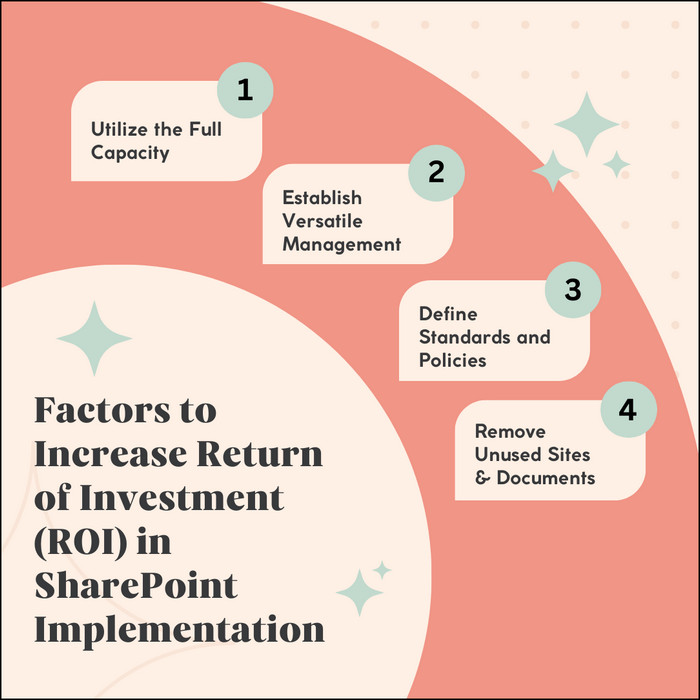
The following factors will add an extra advantage to your implemented SharePoint site and increase the ROI.
Read the following factors to increase ROI in SharePoint implementation:
Utilize the Full Capacity
Microsoft SharePoint is a collection of different applications. It contains Office apps, a data management system, a blogger facility, a collaboration and knowledge hub, etc.
You can utilize all the available Microsoft products and add-ins and reduce the necessity of third-party applications. The internal apps of Microsoft will fasten the work and decrease the cost of the third-party service.
Establish Versatile Management
Versatile management is a must to provide reasonable support to your IT administrators and members. People with knowledge of every sector are much recommended in your SharePoint implementation management.
They can share their expertise on software and hardware with the members to maximize utilization and bring effective solutions to the implementation process.
Define Standards and Policies
Your company must have organization-wide rules and policies for members and documents. It will help to regulate and implement rules in every department.
You need clear rules for document sharing and downloading and straightforward guidelines for authorized people. It will ensure data security and help maintain international business policy.
Remove Unused Sites & Documents
As a SharePoint site owner or admin, you should keep your Organization clear of unwanted sites and documents. You can remove them from your SharePoint and store them in another place by maintaining the retention policy.
It will organize the sites and documents in order and make them easily accessible when needed. It will reduce the difficulties in finding libraries and increase your organization’s productivity.
Once you implement, the above options will increase your return on investment and provide better results for your organization.
Factors to Increase User Adoption
A well-planned user adoption strategy is required to increase the success of SharePoint implementation. The strategy includes incremental implementation, a user-friendly interface and experience, comprehensive training, increasing user engagement, and regular monitoring.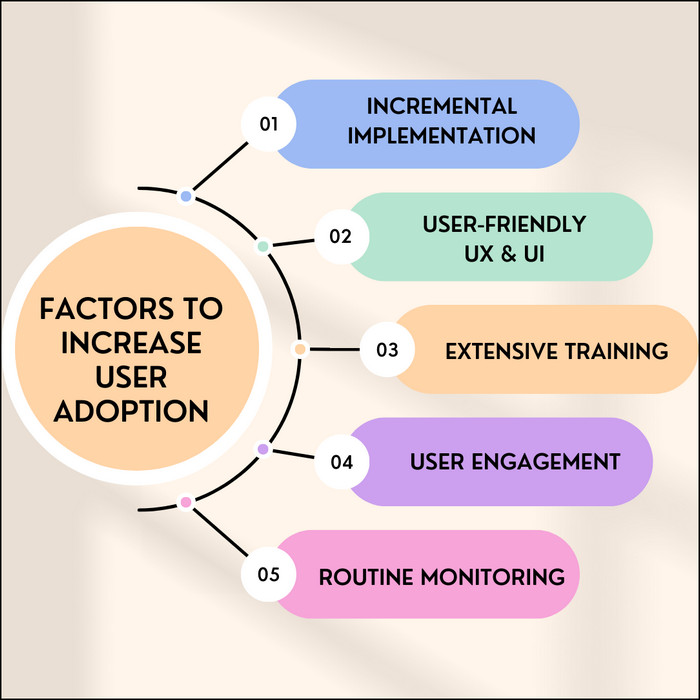
The factors help improve the user interaction with the platform and give continuous feedback for the betterment of the SharePoint implementation.
Here are the factors for increasing user adoption:
Incremental Implementation
Consistent implementation is a must for SharePoint solutions. It’s beneficial for the user to adapt themselves to the new and upcoming changes.
You can assign a pilot group to test the basic and advanced functionalities of the SharePoint site. They will provide feedback and merge them with the users’ opinions, and you can send it to the development team for new implementation.
The changes will help users to operate the site more efficiently and increase their business productivity.
User-Friendly UX & UI
The user interface of your SharePoint is vital for a good user experience. If the design is plain or hard to understand, it won’t bring much value to the user.
If you are not getting positive feedback from the user, you must refine the design and the availability of the options. Better implementation will engage users to use the feature and service more actively.
Users pay attention to features that are attractive but easy to use. You can increase user adoption and make better ROI with the correct implementation.
Extensive Training
There is no exception to training for better user adoption. Microsoft SharePoint has various features which improve and eases business strategy and management.
You can take advantage of data security to secure your documents, metadata for organizing content, personalized content, workflows, and multiple in-built apps and add-ins to assist in work.
But due to a lack of proper training, members don’t use the feature and can’t take full advantage of the Microsoft services.
You must instruct and train them with proper usability guides to take full benefit of the features and provide better user adoption.
User Engagement
User engagement is an excellent way to improve adoption. You can increase engagement through different activities and motivation.
You can add a Key Performance Indicator (KPI) dashboard in your SharePoint site so everyone can see their engagement on the platform.
Acknowledge and appreciate user engagement by providing a badge for comments, communication, content editing, etc.
Also, you can assign an engagement manager to monitor the users and create announcements and tasks for the user.
Routine Monitoring
Besides implementing the SharePoint environment, monitoring the adoption and usage regularly is necessary. It provides up-to-date feedback about the implementation and quickly gives reports about an issue.
It provides a better understanding of the success or failure of the implementation and necessary changes for the next implementation.
After executing the above factors, it will undoubtedly increase user adoption and engagement.
There’s no fixed estimation of Microsoft SharePoint implementation cost. The expense depends on the size of your organization, Microsoft 365 licensing, software, and IT staff. Also, if you establish a server, you must include infrastructure, hardware, and security expenditure.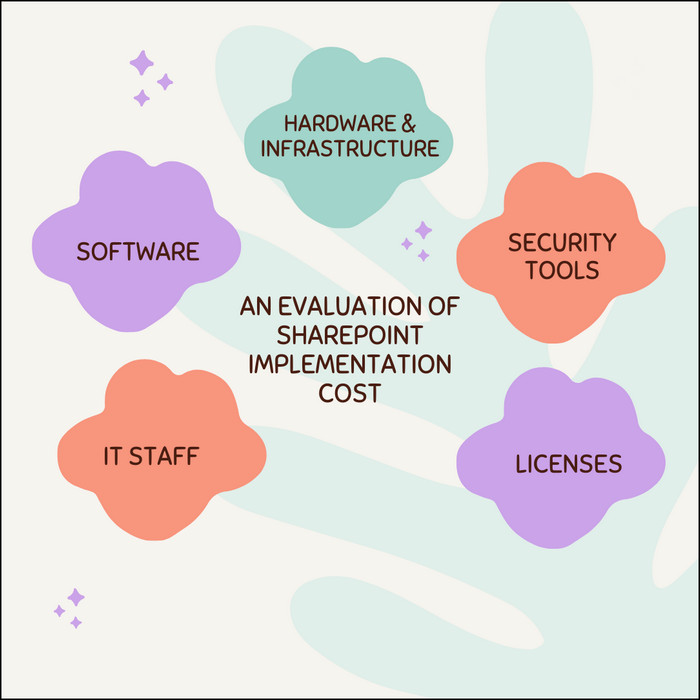
The implementation cost differs for the SharePoint Online and SharePoint servers. A license and IT staff are required in both versions, and you can assume a minimum cost by evaluating it.
Read the essential requirements and their costing for SharePoint implementation:
Licenses
Microsoft 365 license is the same for Online and Server implementation. It starts from $6.00/month and depends on the number of your organization members. Also, if you take additional licenses, it will increase the implementation cost of your SharePoint.
When establishing a server, you will require Microsoft SQL Server and Microsoft Windows Server licenses which will massively increase the licensing cost.
Security Tools
You can use built-in security tools provided by Microsoft and implement them on your site for security functionalities. It’s an efficient way to save time and money.
Also, there are third-party solutions to advanced security, but you’ll need a good amount of resources and a workforce to handle it.
Hardware & Infrastructure
You don’t need any hardware or infrastructure when using SharePoint Online for your SharePoint. Microsoft will provide the facilities to you at no additional cost.
But there are some disadvantages to the Online implementation. You will get limited storage options and have no control over the server.
For the on-premise service, you will use your hardware and storage. The capacity is unlimited, but you’ve to pay for the hardware. Also, the infrastructure costs a lot and varies from location to location.
Software
Besides the Microsoft applications and provided add-ins in SharePoint, you’ll need third-party software to implement in your system.
Different automation, converting, and integration in these third-party applications make them useful for the SharePoint environment. But it comes with a price that varies depending on the software type.
IT Staff
Lastly, you will need expert IT staff to develop, maintain and implement SharePoint. Depending on the work and experience, you have to provide wages, and the total amount depends on the size of your organization.
By evaluating all the required features, the cost of a SharePoint project ranges between $10,000 to $150,000 or even more. But, depending on your environment, the cost can be more or less than the estimation.
Frequently Asked Questions
How long does a SharePoint implementation take?
The implementation of a SharePoint can take from 3-6 months. The discovery and analysis phase takes 2-4 weeks, the design, deployment, and configuration take 4-6 weeks, the testing phase takes 4-5 weeks, the training period takes one week, and the support phase needs about four weeks.
What is the average cost of SharePoint implementation?
The average cost of a SharePoint implementation is $10,000 to $150,000. But it depends on the implementation type, size, and resources.
Ending Note
SharePoint is massively popular with businesses and organizations for its large number of features and services. When creating a business site, you must follow a proper implementation guide to achieve success.
In this article, I’ve explained the complete SharePoint implementation process, the factors to increase income and adoption, and the cost to implement it in detail.
I hope you’ve found the article informative and helpful while implementing the SharePoint site.
Cheers!

